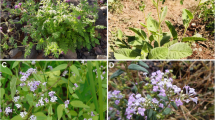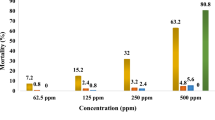Abstract
In an effort to find effective and affordable ways to control of Aedes aegypti L. (Diptera: Culicidae), the larvicidal activities of 94 extracts from ten plant species belonging to eight families [Guettarda grazielae and Spermacoce verticillata (Rubiaceae), Coccoloba mollis and Triplaris americana (Polygonaceae), Eschweilera ovata (Lecytidaceae), Merremia aegyptia (Convolvulaceae), Ouratea nitida (Ochnnaceae), Protium heptaphyllum (Burseraceae), Rourea doniana (Connaraceae), and Tovomita brevistaminea (Guttiferae)], widely found in the northeast of Brazil, were initially screened at 250 µg/mL. Nineteen of the 94 extracts from six plant species (C. mollis, G. grazielae, M. aegyptia, R. doniana, S. verticillata, and T. americana) showed significant activity (>75% mortality) against the fourth instar larvae. Some of these extracts showed 100% mosquito larvae mortality, with LD50 values lower 200 µg/mL. When compared to synthetic insecticide Temephos (LD50 8.7 µg/mL), two of them, hexane (LD50 12.1 µg/mL) and ethyl acetate (LD50 51.6 µg/mL) extracts from stems of R. doniana and G. grazielae, respectively, were the most effective. The isolation and purification of these extracts are in progress and evaluation of these compounds will be needed to identify the active component.
Similar content being viewed by others
References
Amer A, Mehlhorn H (2006) Larvicidal effects of various essential oils against Aedes, Anopheles and Culex larvae. Parasitol Res 99:466–472
Anees AM (2008) Larvicidal activity of Ocimum sanctum Linn. (Labiatae) against Aedes aegypti (L.) and Culex quinquefasciatus (Say). Parasitol Res 103:1451–1453
Cavalcanti ESBC, de Morais SM, Lima MAA, Santana EWPS (2004) Larvicidal activity of essential oils from Brazilian against Aedes aegypti L. Mem Inst Oswaldo Cruz 99(5):541–544
Finney DJ (1971) Probit analysis. Cambridge University Press, Cambridge
Garcez VS, Garcez FR, da Silva LMG, Hamerski L (2009) Larvicidal activity against Aedes aegypti of some plants native to the West-Central region of Brazil. Bioresour Technol 100:6647–6650
Harve G, Kamath V (2004) Larvicidal activity of plant extracts used alone and in combination with known synthetic larvicidal agents against Aedes aegypti. Indian J Exp Biol 42(12):1216–1219
Kamaraj C, Rahuman AA, Bagavan A (2008) Antifeedant and larvicidal effects of plant extracts against Spodoptera litura (F.), Aedes aegypti L. and Culex quinquefasciatus Say. Parasitol Res 103:325–331
Kiran SR, Bhavani K, Devi PS, Rao BRR, Reddy KJ (2006) Composition and larvicidal activity of leaves and stem essential oils of Chloroxylon swietenia DC against Aedes aegypti and Anopheles stephensi. Bioresour Technol 97:2481–2484
Komalamisra N, Trongtokit Y, Rongsriyam Y, Apiwathnasorn C (2005) Screening for larvicidal activity in some Thai plants against four mosquito vector species. Southeast Asian J Trop Med Public Health 36(6):1412–1422
Lima GS, Moura FS, Lemos RPL, Conserva LM (2009) Triterpenos de Guettarda grazielae M.R.V. Barbosa (Rubiaceae). Rev Bras Farmacog 19(1B):284–289
Navarro DMAF, de Oliveira PES, Potting RPJ, Brito AC, Fital SJF, Sant’Ana AEG (2003) The potential attractant or repellent effects of different water types on oviposition in Aedes aegypti L. (Dipt., Culicidae). J Applied Entomol-Zeitsch Angew Entomol 127:46–50
Oliveira PES, Conserva LM, Brito AC, Lemos RPL (2005) Coumarin derivatives from Esenbeckia grandiflora and its larvicidal activity against Aedes aegypti. Pharm Biol 43(1):53–57
Oliveira PES, Santos WS, Conserva LM, Lemos RPL (2008a) Constituintes químicos das folhas e do caule de Coccoloba mollis Casaretto (Polygonaceae). Rev Bras Farmacog 18(Supl):713–717
Oliveira PES, Conserva LM, Lemos RPL (2008b) Chemical constituents from Triplaris americana L. (Polygonaceae). Biochem Syst Ecol 36:134–137
Omena MC, Navarro DMAF, Paula JE, Luna JS, Lima MRF, Sant’Ana AEG (2007) Larvicidal activities against Aedes aegypti of some Brazilian medicinal plants. Bioresour Technol 98:2549–2556
PAHO (Pan American Health Organization) website (2010). Epidemiological alert: dengue outbreaks in the Americas (8 March 2010). <www.paho.org/english/ad/dpc/cd/Dengue.htm.> Accessed 12 March 2010.
Pimenta ATA, Santiago GMP, Arriaga AMC, Menezes GHA, Bezerra SB (2006) Estudo fitoquímico e avaliação da atividade larvicida de Pterodon polygalaeflorus Benth (Leguminosae) sobre Aedes aegypti. Rev Bras Farmacog 16(4):501–505.
Promsiri S, Naksathit A, Kruatrachue M, Thavara U (2006) Evaluations of larvicidal activity of medicinal plant extracts to Aedes aegypti (Diptera: Culicidae) and other effects on a non target fish. Insect Sci 13:179–188
Rahuman AA, Gopalakrishnan G, Venkatesan P, Kannappan G (2008) Larvicidal activity of some Euphorbiaceae plant extracts against Aedes aegypti and Culex quinquefasciatus (Diptera: Culicidae). Parasitol Res 102:867–873
Sharma P, Mohan L, Srivastava CN (2006) Phytoextract-induced developmental deformities in malaria vector. Bioresour Technol 97(14):1599–1604
Sukumar K, Perich MJ, Boobar LR (1991) Botanical derivatives in mosquito control: a review. J Amer Mosquito Control Assoc 7(2):210–237
WHO (World Health Organization) (1981) Instructions for determining the susceptibility or resistance of mosquito larvae to insecticide. WHO/VBC/81.807:1-6.
WHO (World Health Organization) website (2008a) WHO report on global surveillance of epidemic- prone infectious diseases. Dengue and dengue hemorrhagic fever (Chapter 6). <http://www.who.int/csr/resources/publications/surveillance/dengue.pdf>.
WHO (World Health Organization) website (2008b) Dengue and dengue hemorrhagic fever. <http://www.who.int/mediacentre/factsheets/fs117/en>.
Acknowledgments
The authors are grateful to Conselho Nacional de Desenvolvimento Científico e Tecnológico (CNPq), Fundação de Amparo à Pesquisa do Estado de Alagoas (FAPEAL), Ministério da Ciência e Tecnologia-Instituto do Milênio do Semiárido (MCT-IMSEAR), and Banco do Nordeste-Rede Nordestina de Biotecnologia (BNB-RENORBIO) for financial supports and research fellowships.
Author information
Authors and Affiliations
Corresponding author
Rights and permissions
About this article
Cite this article
Oliveira, P.V., Ferreira, J.C., Moura, F.S. et al. Larvicidal activity of 94 extracts from ten plant species of northeastern of Brazil against Aedes aegypti L. (Diptera: Culicidae). Parasitol Res 107, 403–407 (2010). https://doi.org/10.1007/s00436-010-1880-4
Received:
Accepted:
Published:
Issue Date:
DOI: https://doi.org/10.1007/s00436-010-1880-4




